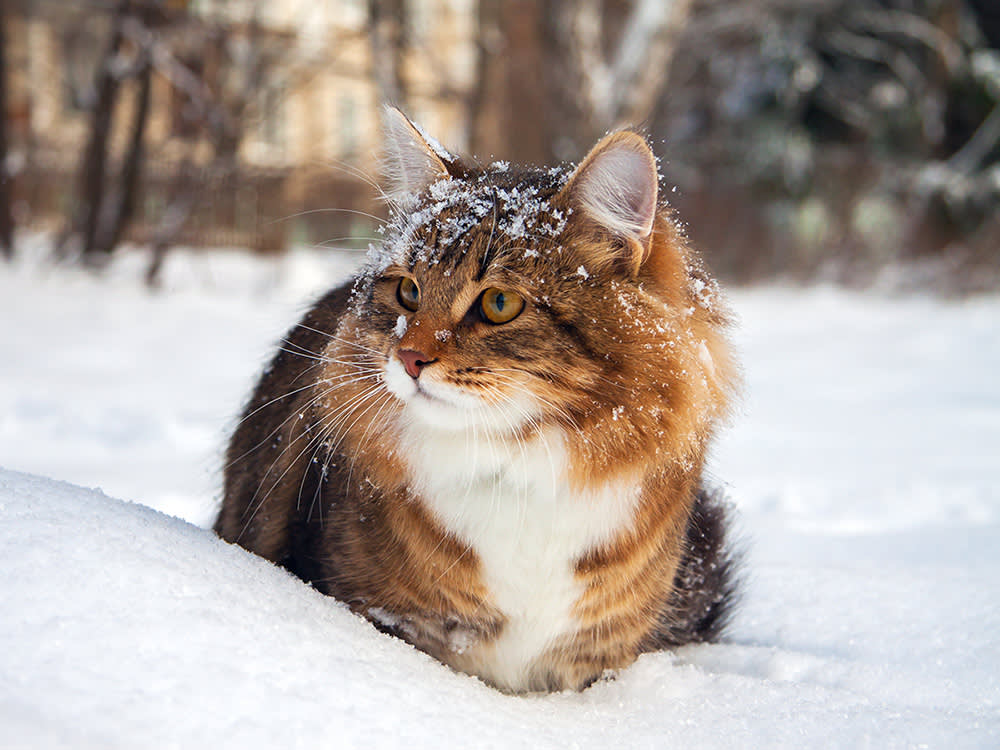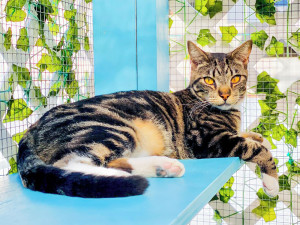How Cold is Too Cold For Outdoor Cats?
Be a good neighbor and learn to spot the signs of frostbite in your community cats.
No matter whether you live in the country or a concrete jungle, there are likely cats in your community. You know the type: the vagabonds who wander between buildings, sun themselves on stoops, and occasionally sidle into your local bodega to graciously help with pest control. While “community cats” are usually able to maintain their colonies without much outside aid — except perhaps some much-needed TNR to keep their numbers in check — there is one critical circumstance in which they desperately need human assistance: frostbite.
Although cats can survive in many climates, during the winter their extremities become vulnerable to the elements. When the environmental temperature drops below freezing (32°F), exposed areas with less fur can become damaged by the extreme cold. But there are several steps we, as their neighbors, can take to prevent this peril of life on the streets for stray cats. We spoke with Luisa Germain, community cats manager of education and training at the ASPCA, to learn how to diagnose and treat frostbite.
Check out customizable policies from our friends at Lemonade Pet Insurance—so you only pay for what you need.
What exactly is frostbite?
Frostbite is damage caused to skin and other tissues due to extreme cold. When the environmental temperature drops below 32°F, blood vessels close to the skin start to narrow or constrict. This constriction of the blood vessels helps to preserve core body temperature by diverting blood toward the core and away from the cooler parts of the body.
In extreme cold or when the body is exposed to cold for long periods, this protective mechanism can reduce blood flow in some areas of the body, especially the extremities (e.g., paws, ears, and tail), to critically low levels. The combination of cold temperature and reduced blood flow can allow the tissues to freeze, causing severe tissue injury and creating “a painful condition that left untreated can severely damage the cat’s most susceptible areas,” according to Germain.
How much do you spend on your pet per year?
Where is an outdoor cat most likely to get frostbite?
Frostbite is most likely to happen in body parts farthest from the heart and in tissues with a lot of exposed surface area. “Community cats, including feral cats, are susceptible to frostbite in areas where there is less fur, like ears, nose, toes, and tails,” says Germain. Additionally, if a cat is wet or damp, these areas are more vulnerable to frostbite.
Are certain cats at higher risk for frostbite?
Cats with heart disease, diabetes mellitus, or other conditions that cause reduced blood flow to the extremities are at greater risk for frostbite. The ear tips of cats are especially vulnerable to frostbite and damage may occur to these tissues very quickly.
How can you tell if a community cat has frostbite?
As frostbitten tissues thaw, they may become red and very painful due to inflammation. The clinical signs of frostbite may take several days to appear, especially if the affected area is small or on non-weight bearing areas, such as the tip of the tail or ears. Severely frostbitten areas will become necrotic or die. As the tissue starts to die, it changes to a dark blue to black color; then, over a period of several days to weeks, it sloughs or falls off. During this time, pus may form or the tissue may develop a foul smell due to secondary bacterial infection.
Though it may be difficult to approach feral community cats, Germain notes, while keeping your distance, pay close attention to the following signs of frostbite:
Discoloration (often pale, gray, or bluish)
Bald, enlarged, or inflamed area
Coldness and/or brittleness of the area when touched
Painful when touched
Swelling
Blisters or skin ulcers
Blackened or dead skin
Rotten smell
How is frostbite in community cats treated?
The list of actions Germain does not recommend is much longer than the short set of instructions she offers for those helping frostbitten cats. “For stray cats who are friendly and comfortable around humans, take the cat out of the cold immediately and try to increase their body temperature by wrapping them in a dry towel. If possible, soak the affected area in warm (not hot) water,” she suggests. Then, wrap the cat in a fresh towel warmed in the dryer. Simple, right?
“For feral cats, do not chase the cat away by aggressively approaching them,” Germain urges. “If you’re TNRM certified, proceed to trap the cat, get them out of the cold into a warm space and contact your veterinarian to secure medical care as soon as possible. If you’re unfamiliar with TNRM, seek guidance from a local rescue group and offer your assistance.” Easy enough!
However, there’s a lot to consider when it comes to community cats. If they’re a part of a “larger group of cats,” also known as a colony, they may have a dedicated caretaker. If you notice food or water containers in the area you found the cat, “leave a sign mentioning your observations, a description of the cat you suspect may have frostbite, and your information,” Germain suggests. While the nature of community cats is that they do not have legal owners, there may be people who look after them and will want to be notified if they’re suddenly missing.
Now, for the list of don'ts. Do NOT:
Touch or rub the area
Apply direct heat
Give any medication unless prescribed by a veterinarian
Warm a frostbitten area if you cannot keep it warm (outdoors)
Expose the area to additional cold as refreezing will more severely injure the tissues
Use direct dry heat such as a heating pad or hair dryer
How can people help prevent frostbite in their community cats?
The great news is that community members can help community cats stay warm during the winter months by providing shelters using everyday materials, like plastic tubs, which make shelters easy and inexpensive to build. “Bideawee’s Feral Cat Initiative Program has put together a useful guide and webinar for building outdoor cat sheltersopens in new tab,” Germain says. “Options vary from super simple winter shelters using Styrofoam shipping boxes, to more elaborate versions using marine coolers.”
There are a few things to note before you get started on this DIY project. “Ensure the entrance is big enough to allow the cat to go inside but not too big that allows for cold wind or larger predators to get inside. Five inches is the ideal size for the entrance,” Germain says. Plus, the material you choose should be resistant to cold temperatures, such as plastic bins. As far as bedding goes, Germain urges you to only use straw. “Stay away from blankets, towels, cat beds and hay as they retain moisture and end up stealing heat from the cats and making them colder.”
If you aren’t much of a DIY-er, you can find many pre-made and ready-to-place winter shelters for sale by many New York City-based community cat groupsopens in new tab.
What other ways can community members help stray cats survive the winter?
“Besides providing winter shelters, community members can help community cats by providing good quality, high calorie food,” Germain suggests. “Wet food is ideal but should be offered only when the cats are around and will eat the food. If left unattended, wet food will freeze.” Community members can also set out fresh water in large plastic bowls, which slows the freezing time.
Perhaps most crucially, it’s important to remember that cats are expert hiders and often seek warmth in car engines during the winter. “Always make sure to tap the sides of your car to allow any napping cat under, or over the tires of your car to move before starting it,” says Germain. This small action could save the lives of many chilly cats this winter.












